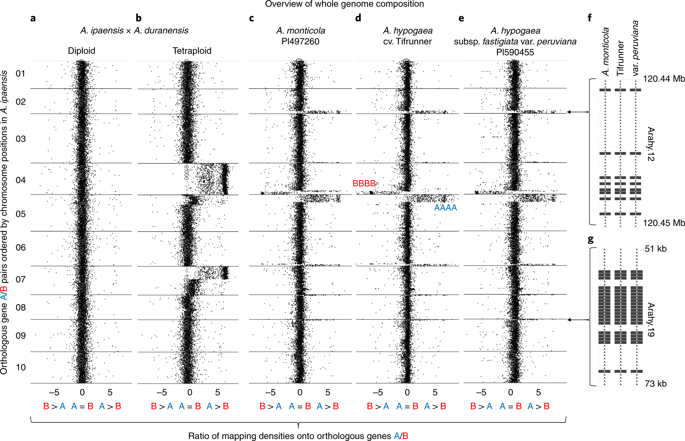Nature Genetics ( IF 31.7 ) Pub Date : 2019-05-01 , DOI: 10.1038/s41588-019-0405-z David J. Bertioli , Jerry Jenkins , Josh Clevenger , Olga Dudchenko , Dongying Gao , Guillermo Seijo , Soraya C. M. Leal-Bertioli , Longhui Ren , Andrew D. Farmer , Manish K. Pandey , Sergio S. Samoluk , Brian Abernathy , Gaurav Agarwal , Carolina Ballén-Taborda , Connor Cameron , Jacqueline Campbell , Carolina Chavarro , Annapurna Chitikineni , Ye Chu , Sudhansu Dash , Moaine El Baidouri , Baozhu Guo , Wei Huang , Kyung Do Kim , Walid Korani , Sophie Lanciano , Christopher G. Lui , Marie Mirouze , Márcio C. Moretzsohn , Melanie Pham , Jin Hee Shin , Kenta Shirasawa , Senjuti Sinharoy , Avinash Sreedasyam , Nathan T. Weeks , Xinyou Zhang , Zheng Zheng , Ziqi Sun , Lutz Froenicke , Erez L. Aiden , Richard Michelmore , Rajeev K. Varshney , C. Corley Holbrook , Ethalinda K. S. Cannon , Brian E. Scheffler , Jane Grimwood , Peggy Ozias-Akins , Steven B. Cannon , Scott A. Jackson , Jeremy Schmutz

|
Like many other crops, the cultivated peanut (Arachis hypogaea L.) is of hybrid origin and has a polyploid genome that contains essentially complete sets of chromosomes from two ancestral species. Here we report the genome sequence of peanut and show that after its polyploid origin, the genome has evolved through mobile-element activity, deletions and by the flow of genetic information between corresponding ancestral chromosomes (that is, homeologous recombination). Uniformity of patterns of homeologous recombination at the ends of chromosomes favors a single origin for cultivated peanut and its wild counterpart A. monticola. However, through much of the genome, homeologous recombination has created diversity. Using new polyploid hybrids made from the ancestral species, we show how this can generate phenotypic changes such as spontaneous changes in the color of the flowers. We suggest that diversity generated by these genetic mechanisms helped to favor the domestication of the polyploid A. hypogaea over other diploid Arachis species cultivated by humans.
中文翻译:

节段异源四倍体花生花生的基因组序列
像许多其他农作物一样,栽培的花生(Arachis hypogaea L.)是杂种起源的,并且具有多倍体基因组,该基因组基本上包含来自两个祖先物种的完整染色体组。在这里,我们报告了花生的基因组序列,并表明在其多倍体起源之后,该基因组通过移动元素活性,缺失和相应祖先染色体之间的遗传信息流动(即同源重组)进化。染色体末端同源重组模式的均匀性有利于栽培花生及其野生对虾A. monticola的单一来源。但是,通过基因组的大部分,同源重组已经产生了多样性。使用由祖先物种制成的新的多倍体杂种,我们展示了它如何产生表型变化,例如花朵颜色的自发变化。我们建议通过这些遗传机制产生的多样性有助于人类多倍体A. hypogaea的驯化,而不是人类栽培的其他二倍体Arachis物种。





























 京公网安备 11010802027423号
京公网安备 11010802027423号